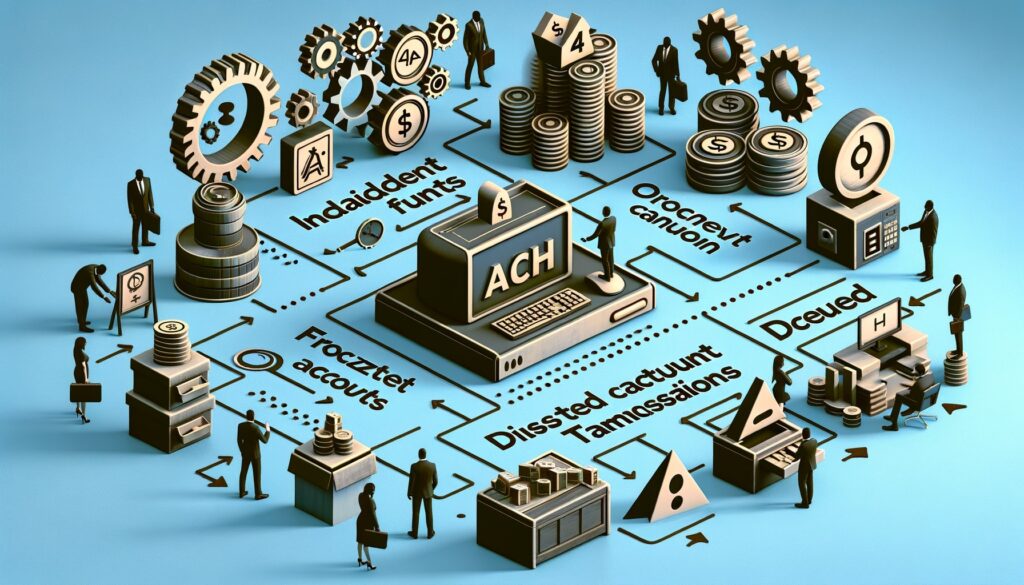
By American November 18, 2024
In today’s digital age, electronic payments have become the norm for businesses and individuals alike. One of the most popular methods of electronic payment is the Automated Clearing House (ACH) system. ACH allows for the transfer of funds between bank accounts, making it convenient and efficient for various financial transactions.
However, there are instances when an ACH transaction is returned, leading to what is known as an ACH return. In this article, we will delve into the world of ACH returns, exploring the basics, common reasons, types, handling procedures, prevention strategies, return codes, timeframes, fees, and frequently asked questions.
ACH returns occur when a transaction initiated through the ACH system is unable to be completed and is sent back to the originating bank. This can happen for a variety of reasons, such as insufficient funds, closed accounts, or incorrect account information. When an ACH return occurs, it is essential for businesses and individuals to understand the causes and how to handle them effectively.
Common Reasons for ACH Returns: Exploring the Causes
There are several common reasons why ACH returns occur. Understanding these causes can help businesses and individuals identify potential issues and take proactive measures to prevent them. One of the primary reasons for ACH returns is insufficient funds in the account. If the account does not have enough money to cover the transaction, the bank will return the ACH payment. This can happen due to various factors, such as unexpected expenses, poor financial management, or delays in depositing funds.
Another common cause of ACH returns is closed accounts. If the account used for the ACH transaction has been closed, the bank will reject the payment and return it to the sender. This can occur when individuals or businesses close their accounts without updating their payment information with relevant parties. It is crucial to keep account information up to date to avoid such issues.
Incorrect account information is also a significant cause of ACH returns. If the account number or routing number provided for the transaction is incorrect, the bank will be unable to process the payment and will return it. This can happen due to typographical errors, outdated information, or miscommunication between parties involved in the transaction.
Types of ACH Returns: A Comprehensive Overview
ACH returns can be classified into different types based on the reason for the return. Understanding these types can help businesses and individuals identify the specific issue and take appropriate action. The most common types of ACH returns include:
- R01 – Insufficient Funds: This return code indicates that the account does not have enough funds to cover the transaction. It is crucial to ensure sufficient funds are available before initiating an ACH payment.
- R02 – Account Closed: This return code signifies that the account used for the transaction has been closed. It is essential to update account information promptly to avoid such returns.
- R03 – No Account/Unable to Locate Account: This return code indicates that the account number provided for the transaction is invalid or cannot be located. Double-checking account information can help prevent this type of return.
- R04 – Invalid Account Number: This return code suggests that the account number provided for the transaction is incorrect. Verifying account details with the recipient can help avoid this issue.
- R05 – Unauthorized Debit to Consumer Account Using Corporate SEC Code: This return code occurs when a consumer account is debited using a corporate SEC code without proper authorization. It is essential to obtain proper authorization before initiating such transactions.
- R06 – Returned per ODFI’s Request: This return code is used when the originating depository financial institution (ODFI) requests the return of an ACH transaction. The reasons for the request can vary and should be communicated between the parties involved.
- R07 – Authorization Revoked by Customer: This return code indicates that the customer has revoked their authorization for the ACH transaction. It is crucial to respect customer preferences and obtain updated authorization if necessary.
- R08 – Payment Stopped: This return code occurs when the customer requests a stop payment on the ACH transaction. It is essential to honor customer requests promptly to avoid this type of return.
- R09 – Uncollected Funds: This return code suggests that the funds in the account are uncollected or on hold. It is crucial to ensure that funds are available and accessible before initiating an ACH payment.
- R10 – Customer Advises Not Authorized: This return code occurs when the customer claims that they did not authorize the ACH transaction. It is essential to investigate such claims and resolve any disputes promptly.
How to Handle ACH Returns: Step-by-Step Guide
When an ACH return occurs, it is crucial to handle it promptly and efficiently. Following a step-by-step guide can help businesses and individuals navigate the process effectively. Here is a comprehensive guide on how to handle ACH returns:
- Identify the return reason: The first step is to determine the reason for the ACH return. This can be done by reviewing the return code provided by the bank. Understanding the specific issue will help in taking appropriate action.
- Review transaction details: Once the return reason is identified, review the transaction details to ensure accuracy. Check the account number, routing number, and other relevant information to verify if any errors were made during the initial transaction.
- Contact the recipient: If the return reason is related to incorrect account information or authorization issues, contact the recipient to rectify the situation. Provide them with the correct information or obtain updated authorization if necessary.
- Assess funds availability: If the return reason is insufficient funds, assess the availability of funds in the account. Determine if there are enough funds to cover the transaction and take appropriate action, such as depositing additional funds or rescheduling the payment.
- Update account information: If the return reason is a closed account or invalid account number, update the account information promptly. Contact the recipient and provide them with the correct account details to avoid future returns.
- Communicate with the bank: Contact the bank to discuss the ACH return and understand their specific requirements for resolving the issue. Provide them with any necessary documentation or information they may need to process the return.
- Rectify the issue: Based on the return reason and the bank’s instructions, take the necessary steps to rectify the issue. This may involve updating account information, depositing funds, obtaining authorization, or resolving any disputes.
- Reschedule the payment: Once the issue is resolved, reschedule the payment if necessary. Ensure that all the necessary information is accurate and up to date to avoid future ACH returns.
- Monitor future transactions: After handling an ACH return, it is essential to monitor future transactions closely. Keep track of account balances, update information as needed, and communicate with recipients to prevent any potential issues.
- Learn from the experience: Use the ACH return as a learning opportunity to improve processes and prevent future returns. Identify any weaknesses or gaps in the system and implement measures to address them effectively.
Preventing ACH Returns: Best Practices and Strategies
While handling ACH returns is essential, preventing them in the first place is even more crucial. Implementing best practices and strategies can significantly reduce the occurrence of ACH returns and ensure smooth financial operations. Here are some effective ways to prevent ACH returns:
- Maintain accurate account information: Ensure that all account information, including account numbers and routing numbers, is accurate and up to date. Regularly review and update this information to avoid any potential issues.
- Obtain proper authorization: Before initiating an ACH transaction, obtain proper authorization from the customer or recipient. This can be in the form of a signed agreement, consent form, or any other legally binding document.
- Verify account details: Double-check the account details provided by the recipient before initiating the ACH transaction. Confirm the account number, routing number, and other relevant information to ensure accuracy.
- Monitor account balances: Keep a close eye on account balances to ensure sufficient funds are available before initiating an ACH payment. Regularly review and manage account balances to avoid any potential issues.
- Communicate with recipients: Maintain open lines of communication with recipients to address any potential issues or changes in account information. Regularly update them on any updates or changes that may affect ACH transactions.
- Educate customers: Provide customers with clear and concise information about ACH transactions, including how they work, potential risks, and their rights and responsibilities. Educated customers are more likely to provide accurate information and authorize transactions appropriately.
- Implement fraud prevention measures: Utilize fraud prevention measures, such as multi-factor authentication, encryption, and secure networks, to protect against unauthorized ACH transactions. Regularly update and review these measures to stay ahead of potential threats.
- Conduct regular audits: Perform regular audits of ACH transactions to identify any potential issues or discrepancies. This can help in detecting and resolving issues before they escalate into ACH returns.
- Train employees: Provide comprehensive training to employees involved in ACH transactions. Ensure they understand the process, potential risks, and best practices to minimize errors and prevent returns.
- Stay updated with regulations: Stay informed about the latest regulations and guidelines related to ACH transactions. Compliance with these regulations is crucial to prevent any potential issues or penalties.
ACH Return Timeframes: Understanding the Process
ACH returns follow a specific timeframe, which is essential to understand for effective handling and resolution. The timeframe for ACH returns can vary depending on various factors, including the return reason and the rules set by the National Automated Clearing House Association (NACHA). Here is a breakdown of the ACH return timeframes:
- Same-Day Returns: Same-day returns are typically processed on the same day the ACH transaction was initiated. These returns are often related to issues such as insufficient funds or closed accounts. It is crucial to address same-day returns promptly to avoid any potential penalties or fees.
- Next-Day Returns: Next-day returns are processed on the next banking day following the initiation of the ACH transaction. These returns are often related to issues such as incorrect account information or authorization problems. It is essential to resolve next-day returns within the specified timeframe to prevent any further complications.
- Extended Returns: Extended returns are processed within a timeframe specified by the NACHA rules. These returns are often related to issues such as fraud, unauthorized transactions, or disputes. The timeframe for extended returns can vary, and it is crucial to adhere to the specified timeframe to avoid any potential penalties or legal consequences.
It is important to note that the timeframe for ACH returns can vary depending on the specific circumstances and the rules set by the NACHA. It is advisable to consult the NACHA rules and guidelines or contact the bank for specific information regarding ACH return timeframes.
ACH Return Fees: What You Need to Know
When an ACH return occurs, there may be associated fees imposed by banks or payment processors. These fees can vary depending on the financial institution and the specific circumstances of the return. It is essential to understand the potential fees to accurately assess the financial impact of ACH returns. Here are some key points to know about ACH return fees:
- Originating Depository Financial Institution (ODFI) Fees: The ODFI, which is the sender’s bank or payment processor, may charge a fee for processing ACH returns. This fee is typically deducted from the sender’s account and can vary depending on the institution’s policies.
- Receiving Depository Financial Institution (RDFI) Fees: The RDFI, which is the recipient’s bank, may also impose fees for processing ACH returns. These fees are typically passed on to the sender and can vary depending on the institution’s fee structure.
- Return Reason Codes: The specific reason for the ACH return, as indicated by the return reason code, can impact the associated fees. Some return reason codes may incur higher fees than others, depending on the policies of the banks or payment processors involved.
- Fee Disclosure: Banks and payment processors are required to disclose their fee structures to customers. It is essential to review these disclosures and understand the potential fees associated with ACH returns.
- Negotiating Fees: In some cases, it may be possible to negotiate or waive ACH return fees with banks or payment processors. This can be particularly relevant for businesses with a high volume of ACH transactions. Clear communication and a strong relationship with financial institutions can help in negotiating favorable fee arrangements.
- Financial Impact: ACH return fees can have a significant financial impact on businesses and individuals. It is crucial to factor in these fees when assessing the cost-effectiveness of ACH transactions and implementing strategies to prevent returns.
It is crucial to review the bank’s fee schedule and policies regarding ACH returns to understand the potential costs involved. Taking proactive measures to prevent ACH returns can help minimize fees and avoid any financial complications.
Frequently Asked Questions
Q1. What is the difference between an ACH return and a chargeback?
An ACH return occurs when an ACH transaction is rejected by the receiving bank, while a chargeback refers to the reversal of a credit card transaction. ACH returns are specific to the ACH system, while chargebacks are associated with credit card payments.
Q2. Can ACH returns be disputed?
Yes, ACH returns can be disputed if there is evidence of an error or misunderstanding. Proper documentation and clear communication with the recipient and financial institutions are crucial in resolving disputes related to ACH returns.
Q3. How long does it take to resolve an ACH return?
The time taken to resolve an ACH return can vary depending on the specific circumstances and the cooperation of all parties involved. Prompt action, clear communication, and accurate documentation can expedite the resolution process.
Q4. Can ACH returns be prevented entirely?
While it may not be possible to prevent ACH returns entirely, implementing best practices and strategies can significantly reduce their occurrence. Proper authorization, accurate account information, and clear communication can help prevent many common reasons for ACH returns.
Q5. Are ACH return fees negotiable?
In some cases, ACH return fees may be negotiable with banks or payment processors, particularly for businesses with a high volume of ACH transactions. Clear communication and a strong relationship with financial institutions can help in negotiating favorable fee arrangements.
Conclusion
ACH returns can be a source of frustration and financial loss for businesses and individuals relying on electronic payments. Understanding the basics, common reasons, types, and how to handle ACH returns effectively is crucial for maintaining financial stability and smooth operations. By implementing best practices, such as obtaining proper authorization, verifying account information, and maintaining accurate records, businesses and individuals can significantly reduce the occurrence of ACH returns.
Clear communication with recipients and financial institutions, as well as prompt action and continuous improvement, are key to handling ACH returns efficiently. By following these guidelines and strategies, businesses and individuals can navigate the world of ACH returns with confidence and minimize the impact of unsuccessful transactions.




